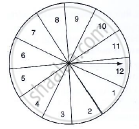Advertisements
Advertisements
Question
In a simultaneous throw of a pair of dice, find the probability of getting neither 9 nor 1 1 as the sum of the numbers on the faces
Solution
In a throw of pair of dice, total no of possible outcomes = 36 (6 × 6) which are
(1, 1) (1, 2) (1, 3) (1, 4) (1, 5) (1, 6)
(2, 1) (2, 2) (2, 3) (2, 4) (2, 5) (2, 6)
(3, 1) (3, 2) (3, 3) (3, 4) (3, 5) (3, 6)
(4, 1) (4, 2) (4, 3) (4, 4) (4, 5) (4, 6)
(5, 1) (5, 2) (5, 3) (5, 4) (5, 5) (5, 6)
(6, 1) (6, 2) (6, 3) (6, 4) (6, 5) (6, 6)
`barE` ⟶ event of getting neither 9 nor 11 as the sum of numbers on faces
E ⟶ getting either 9 or 11 as the sum of no’s on faces
No. of favorable outcomes = 6 {(3, 6) (4, 5) (5, 4) (6, 3) (5, 6) (6, 5)}
Total no. of possible outcomes = 36
We know that, Probability P(E) =`"No.of favorable outcomes"/"Total no.of possible outcomes"`
P(E) =6/36 =1/6
P`(barE)` = 1 − 𝑃 = 1 − 1/6 =5/6
APPEARS IN
RELATED QUESTIONS
Three coins are tossed together. Find the probability of getting no tails
Two unbiased dice are thrown. Find the probability that the total of the numbers on the dice
is greater than 10.
A game of chance consists of spinning an arrow which is equally likely to come to rest pointing to one of the number, 1, 2, 3, ..., 12 as shown in Fig. below. What is the probability that it will point to 10?

Three coins are tossed together. Write all the possible outcomes. Now, find the probability of getting exactly two heads.
A game of chance consists of spinning an arrow which comes to rest pointing at one of the numbers 1, 2, 3, 4, 5, 6, 7, 8 and these are equally likely outcomes. Find the probability that the arrow will point at any factor of 8.
Fill in the blank:
The probability of a sure event is ........ .
What is the probability of not picking a face card when you draw a card at random from a pack of 52 cards?
Two fair dice are rolled simultaneously. The probability that 5 will come up at least once is ______.
A coin is tossed 3 times. List the possible outcomes. Find the probability of getting all heads
Following experiment have equally likely outcomes? Explain.
A trial is made to answer a true-false question. The answer is right or wrong.
